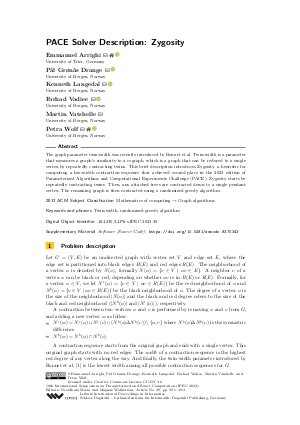PACE Solver Description: Zygosity
Authors
Emmanuel Arrighi  ,
Pål Grønås Drange
,
Pål Grønås Drange  ,
Kenneth Langedal
,
Kenneth Langedal  ,
Farhad Vadiee
,
Farhad Vadiee  ,
Martin Vatshelle,
Petra Wolf
,
Martin Vatshelle,
Petra Wolf 
-
Part of:
Volume:
18th International Symposium on Parameterized and Exact Computation (IPEC 2023)
Part of: Series: Leibniz International Proceedings in Informatics (LIPIcs)
Part of: Conference: International Symposium on Parameterized and Exact Computation (IPEC) - License:
 Creative Commons Attribution 4.0 International license
Creative Commons Attribution 4.0 International license
- Publication Date: 2023-12-13
File

PDF
LIPIcs.IPEC.2023.39.pdf
- Filesize: 471 kB
- 3 pages
Document Identifiers
Subject Classification
ACM Subject Classification
- Mathematics of computing → Graph algorithms
Keywords
- Twin-width
- randomized greedy algorithm
Metrics
- Access Statistics
-
Total Accesses (updated on a weekly basis)
0PDF Downloads0Metadata Views
Abstract
The graph parameter twin-width was recently introduced by Bonnet et al. Twin-width is a parameter that measures a graph’s similarity to a cograph, which is a graph that can be reduced to a single vertex by repeatedly contracting twins. This brief description introduces Zygosity, a heuristic for computing a low-width contraction sequence that achieved second place in the 2023 edition of Parameterized Algorithms and Computational Experiments Challenge (PACE). Zygosity starts by repeatedly contracting twins. Then, any attached trees are contracted down to a single pendant vertex. The remaining graph is then contracted using a randomized greedy algorithm.
Cite As Get BibTex
Emmanuel Arrighi, Pål Grønås Drange, Kenneth Langedal, Farhad Vadiee, Martin Vatshelle, and Petra Wolf. PACE Solver Description: Zygosity. In 18th International Symposium on Parameterized and Exact Computation (IPEC 2023). Leibniz International Proceedings in Informatics (LIPIcs), Volume 285, pp. 39:1-39:3, Schloss Dagstuhl – Leibniz-Zentrum für Informatik (2023)
https://doi.org/10.4230/LIPIcs.IPEC.2023.39
BibTex
@InProceedings{arrighi_et_al:LIPIcs.IPEC.2023.39,
author = {Arrighi, Emmanuel and Drange, P\r{a}l Gr{\o}n\r{a}s and Langedal, Kenneth and Vadiee, Farhad and Vatshelle, Martin and Wolf, Petra},
title = {{PACE Solver Description: Zygosity}},
booktitle = {18th International Symposium on Parameterized and Exact Computation (IPEC 2023)},
pages = {39:1--39:3},
series = {Leibniz International Proceedings in Informatics (LIPIcs)},
ISBN = {978-3-95977-305-8},
ISSN = {1868-8969},
year = {2023},
volume = {285},
editor = {Misra, Neeldhara and Wahlstr\"{o}m, Magnus},
publisher = {Schloss Dagstuhl -- Leibniz-Zentrum f{\"u}r Informatik},
address = {Dagstuhl, Germany},
URL = {https://drops.dagstuhl.de/entities/document/10.4230/LIPIcs.IPEC.2023.39},
URN = {urn:nbn:de:0030-drops-194583},
doi = {10.4230/LIPIcs.IPEC.2023.39},
annote = {Keywords: Twin-width, randomized greedy algorithm}
}
Author Details
Supplementary Materials
- Software (Source Code) https://doi.org/10.5281/zenodo.8370343

